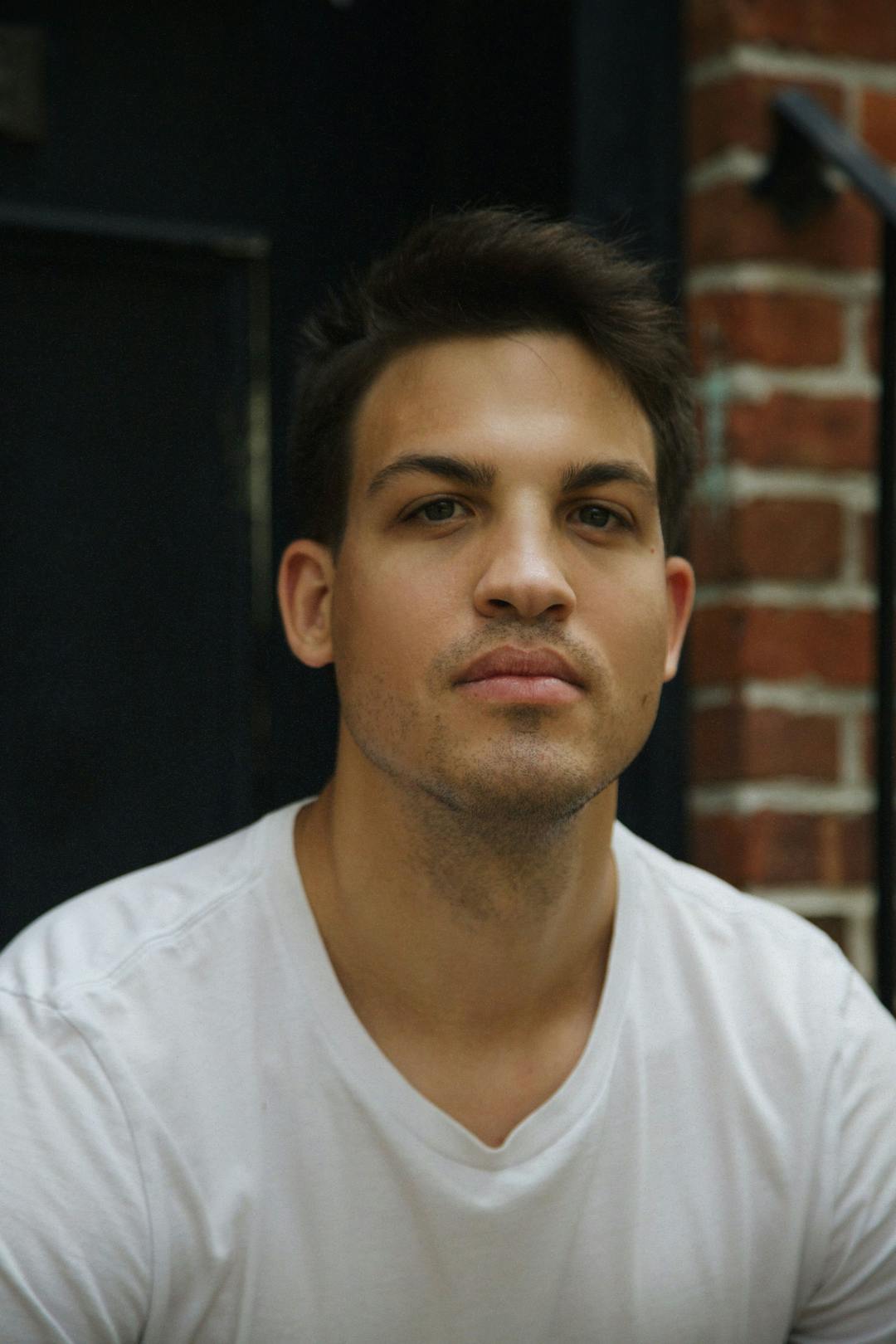
Derrick Tillman
Bridging the Gap
As the founder of Bridging the Gap, Derrick Tillman has made it his life’s work to build not just buildings, but also to build up communities and the people that live in them.
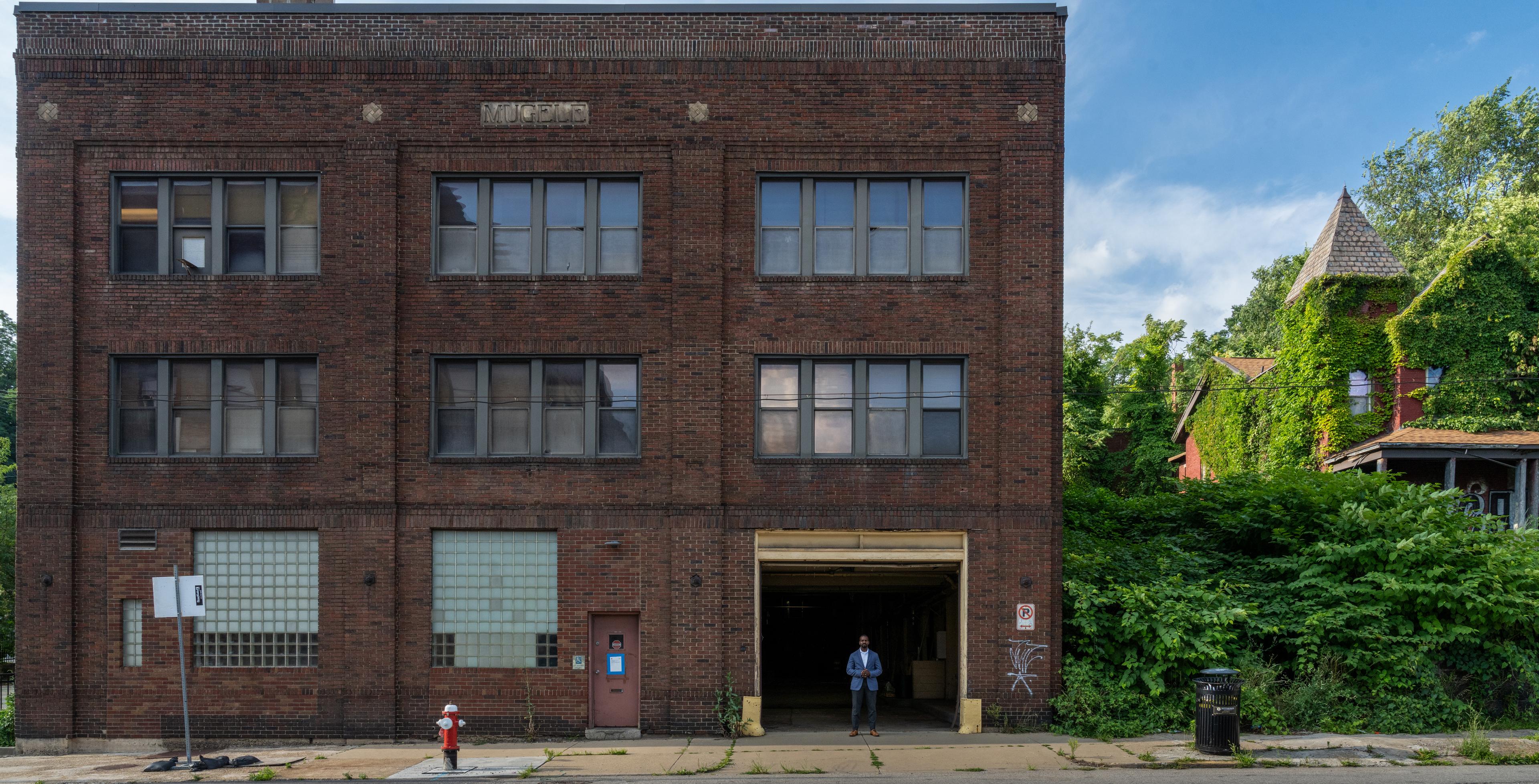
By Nancy Andrews for Commonplace
Can you briefly introduce yourself and the work that you do?
I'm Derrick Tillman, President and CEO of Bridging the Gap Development. We're a real estate development firm based in Pittsburgh that was founded in 2006 and our mission is broadly to bridge gaps – not just gaps in development, but gaps in opportunity as well.
We do that by working closely with communities to identify their needs and by designing thoughtful public-private developments in direct response to those goals. So our projects feature a variety of different asset types, such as affordable housing; market rate housing, including workforce and mixed-income housing; commercial development, including retail, office, and mixed use; and community and cultural space, like community centers and parks. By being responsive to the communities we serve, we create good jobs and other economic opportunities for local residents, reduce the rent burden on families, and support local minority and women-owned businesses through our contracting and hiring.
That’s why when we say that we’re bridging a gap, we don't just mean by building new buildings. We’re also looking to build people up because we know that strong and stable people and families build strong and healthy communities.
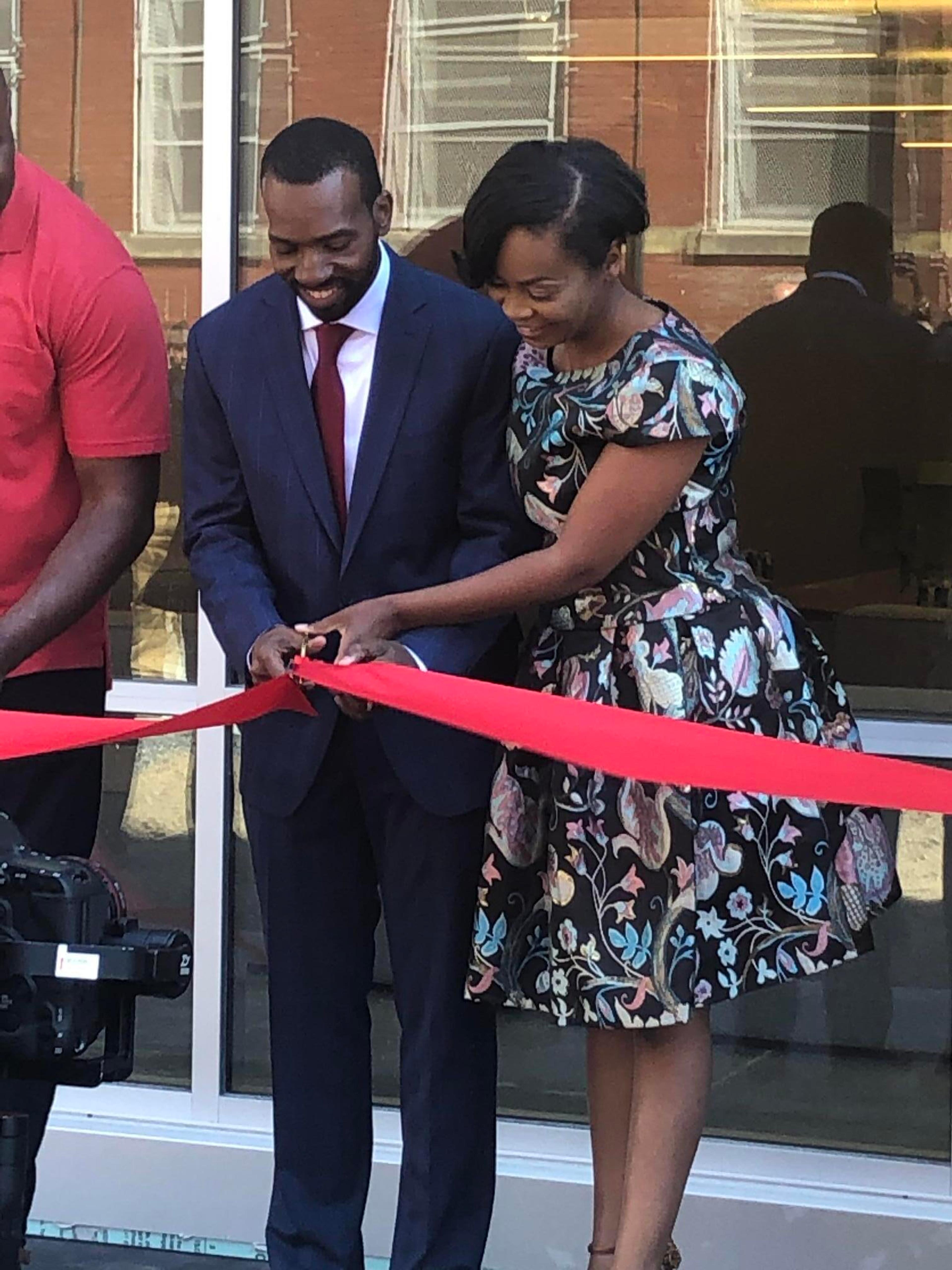
Ribbon cutting ceremony for the Miller Street Apartments
Courtesy of Bridging the Gap
Can you share some details about your personal background and the path you took to get to where you are today?
Sure. I was born in St. Petersburg, Florida, but I've lived in Pittsburgh since I was very young. I grew up in Section 8 housing and we moved around a lot growing up because my mom wanted to ensure I was in a good environment with good schools and such. I didn't like it when I was young, but looking back, I realize it really gave me an understanding of different neighborhood dynamics, as well as an affinity for and relationships to various communities, so it actually kind of fuels and guides my work today.
I graduated from the University of Pittsburgh with a degree in information science in 2004. That was actually a very discouraging time for me because I felt I had done everything I was told to do – got good grades, networked, did internships – but when I got interviews, sometimes second or even third interviews, I was being passed up. However, I had met my mentor, Greg Spencer, a retired executive with a small real estate company, through the Coro Center for Civic Leadership while I was in college. I reached out and he ended up offering me a job managing the turnaround of some of his vacant properties and his portfolio. That was my first opportunity out of college and my first practical experience in real estate.
Fast forwarding a bit, I eventually bought my first property and built up a portfolio. In 2006, I went back to Greg and that’s when we founded Bridging the Gap. But in ‘07 we took an opportunity to own a restaurant at the Pittsburgh International Airport; then, in ‘08, I branched out and started the weatherization company, which grew to be a multi-million dollar company over the next few years.
By around 2012 though, I was starting to feel empty because real estate, which is what I started the company for, ended up being the least of what I was doing. At that point, my wife and I had already built a decent size portfolio after getting married around 2009. We were looking at two options: either we could grow our portfolio into hundreds, or even thousands, of units and cruise off into the sunset, or we could jump into the heavily political world of development.
A few things helped with that decision. My thinking was, if I just became a large landlord and investor, that would of course benefit me, my wife, and maybe a few subcontractors working for us. But if we went into development, we could create more opportunities for many more contractors and we could influence development and create positive impacts on neighborhoods for the next 20 to 50 years. I also thought back to my childhood and some of those experiences I had growing up in poverty and that really sharpened my focus on development into more of a calling, rather than just another business opportunity.
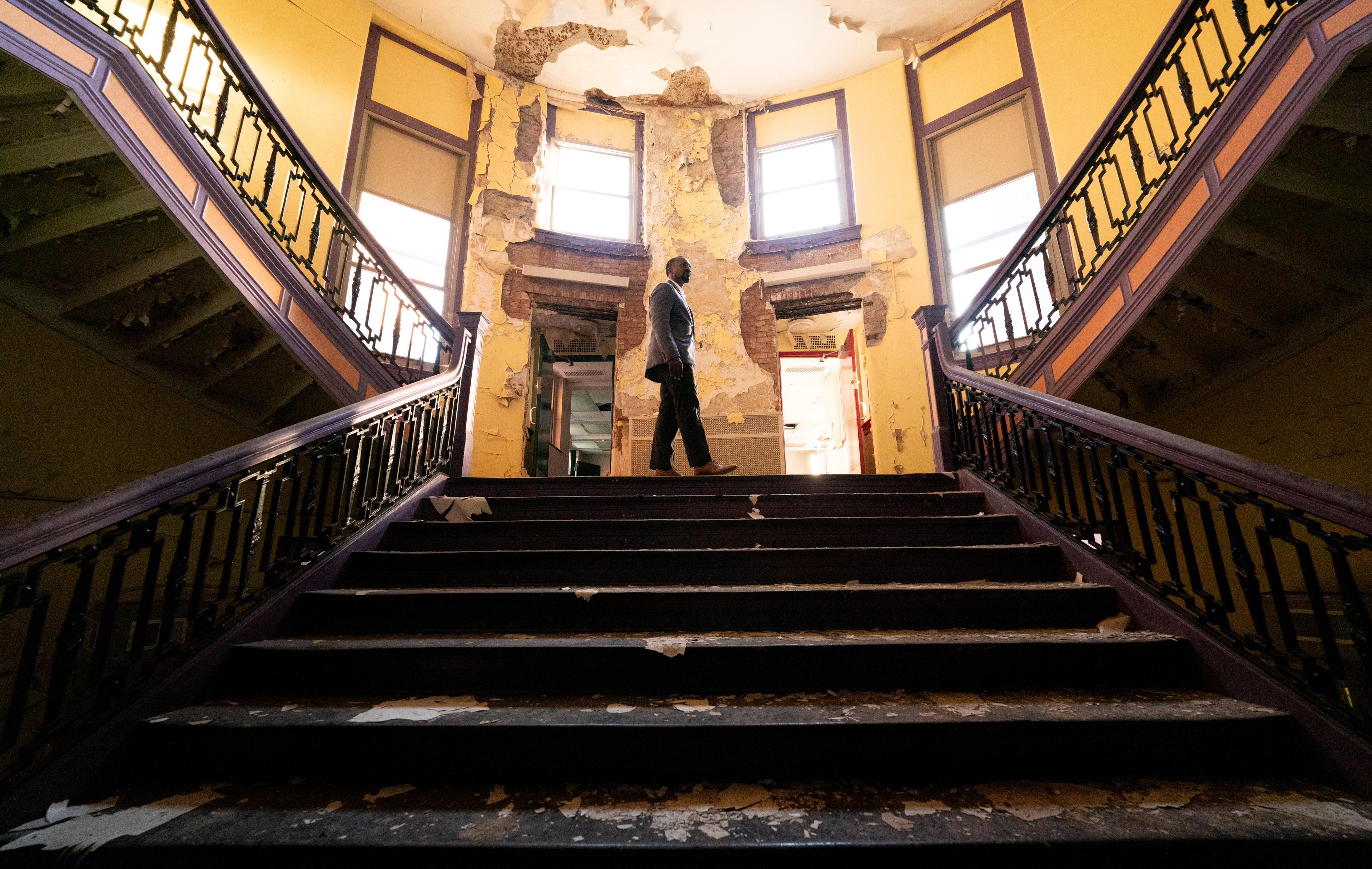
The grand staircase at the Miller School
By Nancy Andrews for Commonplace
How many and what kinds of projects have you completed to date?
I’ll start with the existing portfolio. As I mentioned, our track record includes the weatherization of over 900 homes and the rehab of over 100 housing units; these were mostly smaller properties – single-family, duplexes, quads, with the largest being a 20-unit building. In 2018, we finished the Miller Street Apartments, which was a $12 million ground-up affordable housing project involving Low Income Housing Tax Credits*. And right now we’re about 95% complete on the renovation of a 6-unit historic property that was formerly a mansion in a nearby community called Manchester. That's what we've completed to date.
As for what we’re working on, we just broke ground on a brand new community facility in Pittsburgh. It’s a public-private development that will feature state of the art athletics facilities, including a football field with changing rooms for both home and away teams, as well as a brand new swimming pool and playground. There will also be a film study room and other spaces for mentorship and personal development. The front part of the site will be a cultural space with an outdoor amphitheater and green space that will host movie screenings and other types of community events and programming. We've also embedded public art all throughout the site to commemorate and celebrate some of the leaders that have come from the community – which actually includes myself as I graduated from high school here. That project is not yet completed, but it is fully funded and underway.
We're also set to close next month on our Fifth & Dinwiddie project, which is a New Market Tax Credit** (NMTC) deal that will feature an adaptive reuse of a 20,000 square foot building that was a former City of Pittsburgh public works building. In addition to renovating the existing space, we’ll be adding 20,000 square feet to the footprint, bringing the total to 40,000 square feet. There will be office space, including co-working space for smaller businesses, a coffee shop, and a training center for clean energy jobs, teaching folks how to install solar panels or electric vehicle charging stations, among other things.
Directly across the street from that project, we are working on a ground-up mixed-income multifamily building with 171 housing units and 12,000 square feet of retail space. We’re still working to bridge some gaps in the financing, but we have 95% of our capital stack and are set to close in the fourth quarter of this year. And then lastly, we bought the Miller School, which is located across the street from the Miller Street Apartments project I mentioned earlier. We’ll be breaking ground on that in September of this year.
So in our portfolio there are lots of different things that we've already done, as well as a pretty decent pipeline that will start breaking ground over the next few months. But we also have pipeline projects coming after those and if we can access more capital that will only add fuel to the fire.
* LIHTC (Low-Income Housing Tax Credit) Program promotes the creation and maintenance of affordable rental housing for low-income individuals and families by providing tax credits to developers and investors who invest in eligible housing projects.
** The New Market Tax Credit (NMTC) Program attracts private capital into low-income communities by permitting investors to receive a tax credit against their federal income tax in exchange for making equity investments in specialized financial intermediaries called Community Development Entities (CDEs).

The Sheffield Residences, located in the historic Pittsburgh neighborhood of Manchester
Courtesy of Bridging the Gap
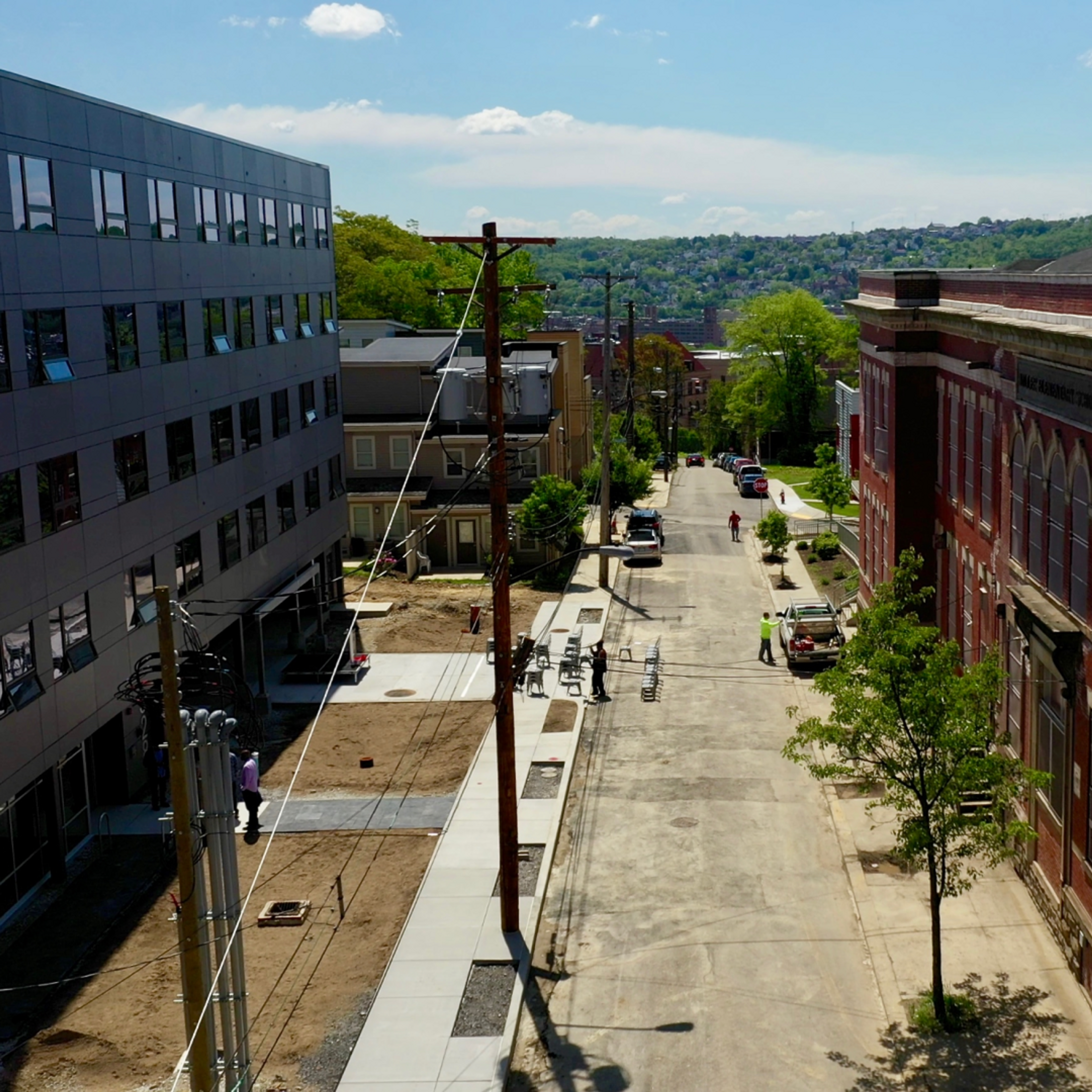
The completed Miller Street Apartments (left) are located right across the street from BTG's upcoming Miller School project (right)
Can you describe your general approach to development? What are you looking for when deciding whether or not to take on a project?
Our approach to development is to pursue both impact and profitability. Because of my roots and where I came from, I’m very conscious of the types of challenges that communities plagued by disinvestment face and I feel a sort of social responsibility for trying to address them. However, being in commercial real estate and development, I also understand that on the financial side there is an expectation of performance. So the goal is really to marry the two and approach projects with those lenses aligned, as opposed to only being focused on the social aspects or only being focused on the profit.
In terms of project criteria, besides standard ones like market viability, we look for places where there is an openness not just to developers, but specifically to minority developers. In those areas, the political landscape is structured in a way that we can actually win and the community wants to see and welcome more minority developers. That doesn’t mean that there won’t still be challenges, but at the very least one of those won’t be outright racism. And related to that is the availability of public dollars; we’re looking for areas where the community is actively pursuing more housing or other types of development, but still understands that they have a role in bringing capital and other forms of subsidy to help projects pencil.
And lastly, we prefer being in places where we have relationships on the ground that help to advance us from a grassroots perspective and to support us at the professional level. We’ll consider questions like, “Do we have team members that understand the local zoning? Do we have any connections that can guide us through entitlements?” That knowledge really helps to get the ball rolling because it gives us more certainty on project feasibility and allows us to gauge levels of community support for our proposals.

A rendering of Fifth & Dinwiddie West, which will feature ground-floor retail, office space, and 171 mixed-income housing units.
Courtesy of Bridging the Gap
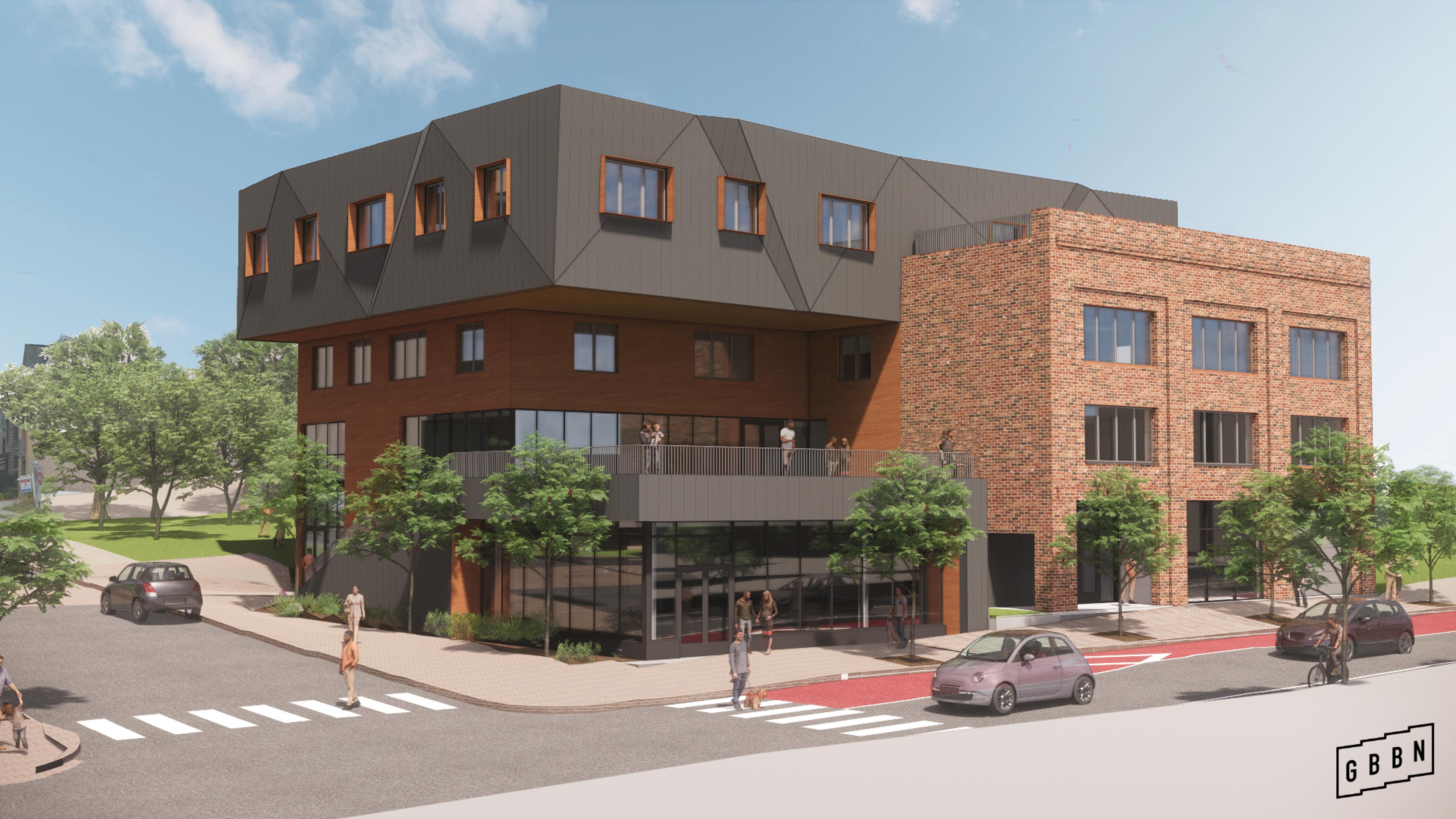
A rendering of Fifth & Dinwiddie East, which will house a training center for clean energy jobs, retail, and office, including co-working space. Both buildings of Fifth & Dinwiddie will receive a Passive House Certification.
Is there a project in particular that you could highlight that really exemplifies that approach?
Absolutely. I’ll share more about Fifth & Dinwiddie. In that project, we went through a very robust community engagement process – I think we had about 10 community meetings. And over the course of those, the community asked for things that improved the project and other things that we couldn’t do; sometimes they didn’t make sense financially, or sometimes it just wasn’t a good addition to the project. But either way, with that approach we were able to take the best ideas, while still making sure that the project remained financially viable. And in the end I think that brought forth a better project that also got a much better reception from the community.
That kind of community-centered approach earned us support from two registered community organizations, as well as various elected officials, like the councilman, the mayor, and state senators and reps. And that all has important impacts on the financing side because one side of that project is a NMTC deal, while the other side is a LIHTC project, which means we need strong political support to make it happen. It’s a very complicated structure that I think speaks to our expertise in managing the relationships and processes that make the project possible, as well as our creativity in accessing financing that allows it to pencil. And that’s how we can walk that fine line between a project’s impact and its financial viability.

By Nancy Andrews for Commonplace
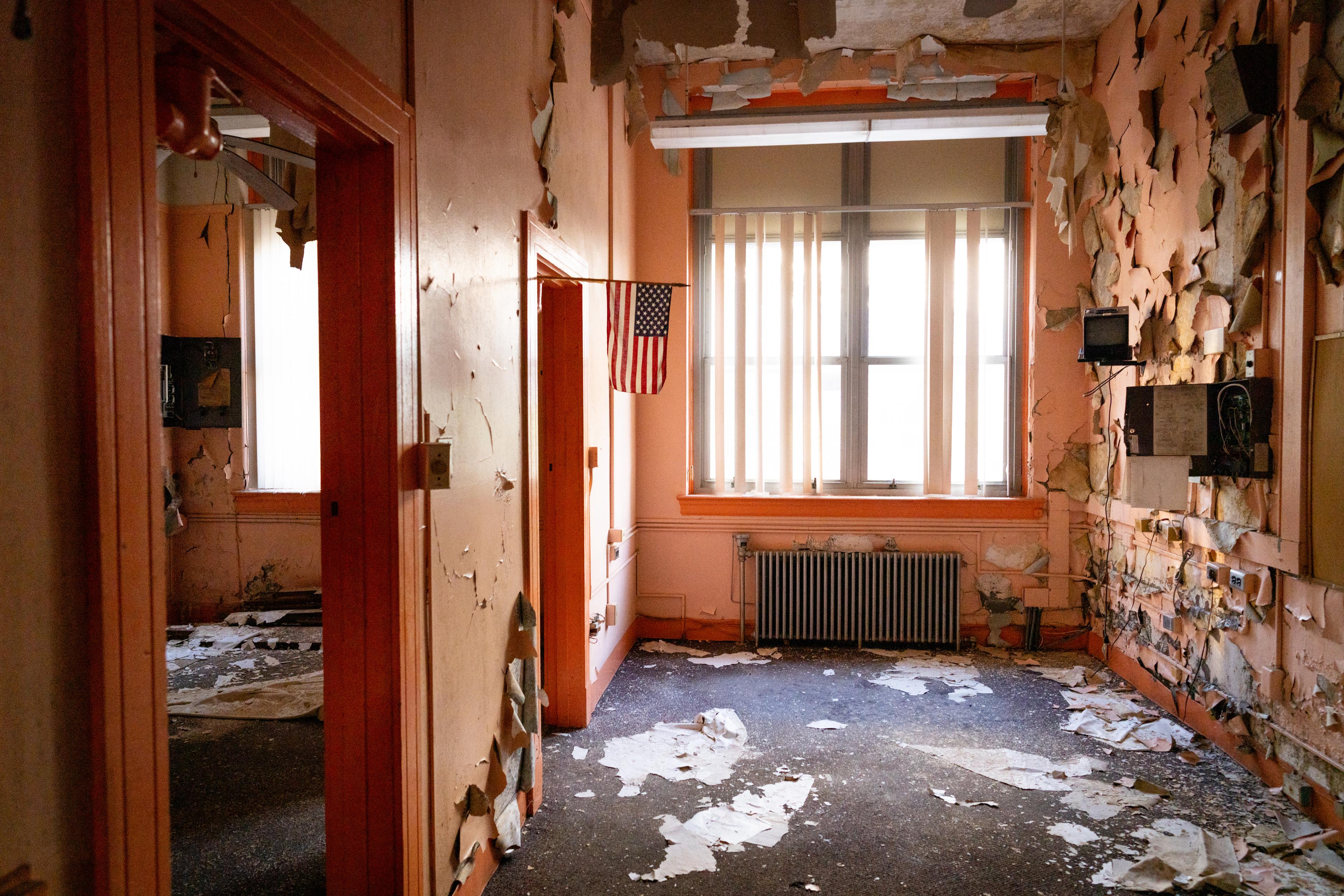
The Miller School project is scheduled to break ground in September 2023
By Nancy Andrews for Commonplace
You mentioned briefly that you need more capital to build up your momentum. Can you just elaborate broadly on that topic?
Real estate development is a very capital intensive business. Most developers get in through an inheritance or by having a rich uncle, but when you don't come from generational wealth, it's very difficult to be in this industry because your ability to access capital impacts every step of the process.
On the front end, you have pre-development costs, which are hundreds of thousands of dollars; in some cases, it can be millions. There’s also acquisition; you often encounter motivated sellers, which means that if you're unable to sign a contract and close on land because you don’t have your capital lined up, you lose the whole deal, along with everything you already spent trying to put it together. Then there are the entitlement costs: architects, engineers, all the different costs that are necessary to advance a project to an early stage. You need all that in place before you’re really able to attract equity and financing.
Then there's the back end. Most projects have requirements around having enough liquidity to serve as a backstop to the project; and, you know, if that was already a struggle in pre-development, there clearly isn't enough liquidity to meet those demands. And also there are guarantees – construction completion guarantees, operating deficit guarantees – which again point back to your liquidity and net worth. To bring it back to us, our net worth is pretty good, but the liquidity is challenging because we have to put the money that we make on our deals and reinvest it into the next project. That really limits the number of projects that we can do and our ability to scale.
There are other areas where capital access is important that aren’t directly tied to project costs too. One area is gap financing, which is typically filled through equity. If you have it, then you can structure it in a variety of creative ways, like a soft loan or cash flow loan to name a few. But if you don’t, then your project stops until you can fill those gaps. Another area is operating costs. So for example, we've built up our capacity with a smaller team supplemented by consultants. That has gotten us this far, but consultants are expensive, so it costs more to do everything. If we had the capital to support a larger internal team, we could reduce those costs and at the same time be able to handle more projects and advance them faster, which would all help to stretch our capital further. We would also be able to do homeownership projects, condo deals, and other market rate projects, which would greatly improve our balance sheet.
The last thing I’d mention is that if you don’t have this excess cash sitting around to satisfy lenders and all their different guarantees, they will typically hold your developer fee hostage. And that’s a difficult position to be in because that developer fee is our lifeblood; it’s why we're really doing this, especially in affordable housing where there’s pretty much no cash flow coming from the project. It’s basically the only true profit from the project and you need it to keep your company running, so you may have to take a bridge loan until you get it.
"By the time you get your fee, your profits are watered down and you still have to pay your loan back. At the end, you’ll look back and see that you haven’t really advanced; sure, you’ll have more experience, but from a liquidity and net worth perspective, you really will not have moved forward. All because of a lack of access to capital."
What drives you and motivates you to do what you do?
As I mentioned, I grew up in poverty, and poverty is traumatic. A lot of my motivation comes from those personal experiences. So number one, I want to make sure that my family never has to experience those things and building generational wealth is one way of accomplishing that. And to take that beyond the personal level, I want those efforts to also improve the conditions of communities like the ones that I grew up in and create economic opportunity for the families that live in them.
In these neighborhoods, even a simple thing like being able to pay a utilities bill without stress can be a struggle. I've personally lived through times when our utilities were cut off – not a good time, not a great experience. And I know firsthand how much of a difference a good, well-paid job would have made for my family when we were struggling to make ends meet. That’s one of the reasons why it was so important for us to include a job training facility in our project; if we can give people the right training lined up with the right opportunity, that could really be a game changer for their family and their trajectory. And that’s also why sustainable development and energy efficiency are important for us – besides the environmental benefits, which of course are great, these goals also reduce the utilities burden on families. This multifaceted approach allows us to create what I think is a holistic solution to some of these issues.
And finally, I just love real estate. I love taking something that was forsaken and dilapidated and bringing forth its true beauty – kind of like raising a castle in the midst of a swamp. There is a deep satisfaction that comes from that and it really drives me to bring these projects to fruition.

By Nancy Andrews for Commonplace
BTG has a wide array of different projects, including housing, retail, and other commercial components, which is unusual, as most developers tend to specialize. Even if you’re not pursuing a specific type of development, is there at least a specific impact that you're looking to achieve through your work?
I would say not really because that depends on what a specific community’s needs are. Different communities need different things, so there’s a lot of variation. One community may have enough affordable housing and ask for market rate housing, while another may want more mixed-income housing.
I actually think that gives us an advantage because it allows us to play ball in different markets and be more fluid on what we can offer. You're right – most developers do typically focus only on affordable or market rate, and some even only on commercial. However, being able to take on any of those property types is important for the types of projects that we work on, especially when it comes to things like master planned communities. In those cases, you need a combination of different types of spaces to be able to fill out an entire block, so it helps to be well-versed in commercial real estate, as well as housing; it is very important.
"By taking our expertise and adding in our social consciousness and local relationships, we have been able to really build up a huge amount of trust and goodwill in these communities. That gives us a major competitive advantage in our space. Really, the only missing link for us is access to capital."
What do you think of the tension between financial returns and impact? Do you think that the two are mutually exclusive?
I don't. I truly, truly believe that you can make money and be socially responsible at the same time. However, there are definitely times where you’re asked to change an aspect of a project and it forces you to consider if you’re willing to die on that hill. For us, if we can move a project forward with the community’s support at the cost of taking less profit, we're oftentimes willing to make that trade-off. For many developers though that is a hard no – they won’t lower their fee, or maybe the cash flow on the back end doesn’t meet their thresholds.
That said, there's still a threshold where a project no longer makes sense financially and in those cases oftentimes we’ll push back, or we’ll try to be a bit more creative and respond with an ask for more public subsidy. So, even in those tough situations, I think we're still pretty open to thinking about it more creatively to make a project happen.

The interior of the Miller School
By Nancy Andrews for Commonplace

You recently appeared in a New York Times article* about the difficulties Black and Brown developers face in accessing capital for their projects. Can you elaborate on your thoughts about this issue?
I think many of those difficulties come down to a combination of both institutionalized racism and people simply not knowing about us. There are definitely impact investors out there that are looking to match capital with the type of work that we're doing. We’re becoming a little bit more known now – for example, you found out about me because of that New York Times article – but there are still many folks out there who still don't know who we are. And on the other side of it, I do think that, structurally, there's still institutional racism within the DNA of the real estate development industry; it is really not set up for folks like myself. So our task is to find those investors who are aligned with us, our mission, and who we are. And when we encounter folks who aren’t aligned, that’s okay too – we just kind of have to roll with the punches and keep it moving.
We have put out the clarion call in the past and had some success finding aligned impact-driven investors. And it's definitely been a difference maker between some projects moving forward or not. However, those dollar amounts tend to be smaller. When it comes to larger institutional investors, we haven't yet found that perfect marriage. So on one hand, the capital we’ve been able to access is certainly helpful, but on the other hand it's limited because it’s only one project. We can't keep going back to the same sources over and over again because they might have only invested on a case-by-case basis, or they might have limited funds that they need to spread around. The result is that it allows me to get a project done, but it doesn't give me the ability to truly scale.
* ‘Excuse After Excuse’: Black and Latino Developers Face Barriers to Success by Colette Coleman
"We're at the point now where we need institutional impact investors so we can do a hundred, ten, or even just five of these projects, as opposed to a one-off investment and then having to scour the nation for gap financing to make it work. It's just not the way to do it."
Are there any solutions that could potentially help you and folks like you overcome the challenge of accessing capital?
I definitely have a few ideas; some of which we've been actively working to put in motion. Firstly, the public sector has to play a more meaningful role in supporting Black and Brown developers because when the private sector doesn't step up, you need the public sector to play a more meaningful role. And so we founded the Black Developers Coalition, made up of Black developers across the state of Pennsylvania, to advocate for funding, like equity or other forms of patient capital, from our elected officials to help bridge gaps and get projects moving.
Another approach has been to reach out to foundations and other philanthropic organizations. These have definitely played a meaningful role in supporting our work, but, again, it's for one project and only for a limited amount. For example, we may need $3 million and we’ll get maybe $500,000 – it’s certainly helpful and we're thankful for it, but it doesn't quite bridge the gap. And again that points to why institutional-level involvement is important. One thing that would help here is for the foundations to be more intentional. They invest their money in various ways, like through endowments, and I think the portion invested in Black and Brown developers typically makes up a relatively smaller portion of their funds. The vast majority of funds are invested in other institutions and diverting just a piece of that specifically for Black and Brown developers would be incredibly helpful.
Also, pension funds could also be more intentional about investing with us, and that could mean investing with us directly, or placing their funds with Black and Brown investment managers, who better understand us, our business, and our community’s needs. Similarly, I think there needs to be more intentionality from the banking industry. They’ve definitely made statements and are doing some things that help, but we’re nowhere close to a major effort to really lift Black and Brown developers, like, for example, a large institutional fund on a national scale. There are definitely no limits to the resources available in this country; with trillions of dollars flowing through capital markets, we should be able to access all the capital that we need, yet we're still facing these challenges because the intentionality to distribute funds and invest in that way is still missing.
The last thing I’ll mention is that we have been plugging into Community Development Financial Institutions (CDFIs), particularly ones like Enterprise, and that has been very helpful. There are many different kinds of platforms and investment vehicles among CDFIs that are really making a huge difference for us. For example, groups like Enterprise have more of a holistic approach and can help across the capital stack, but there are CDFIs that only help with certain portions, like pre-development funding or backstop guarantees. Either way, even if they don’t have everything that you might need, they’re able to assist in a variety of ways, so that is one solution I would definitely recommend.
"There are definitely no limits to the resources available in this country; with trillions of dollars flowing through capital markets, we should be able to access all the capital that we need, yet we're still facing these challenges because the intentionality to distribute funds and invest in that way is still missing."
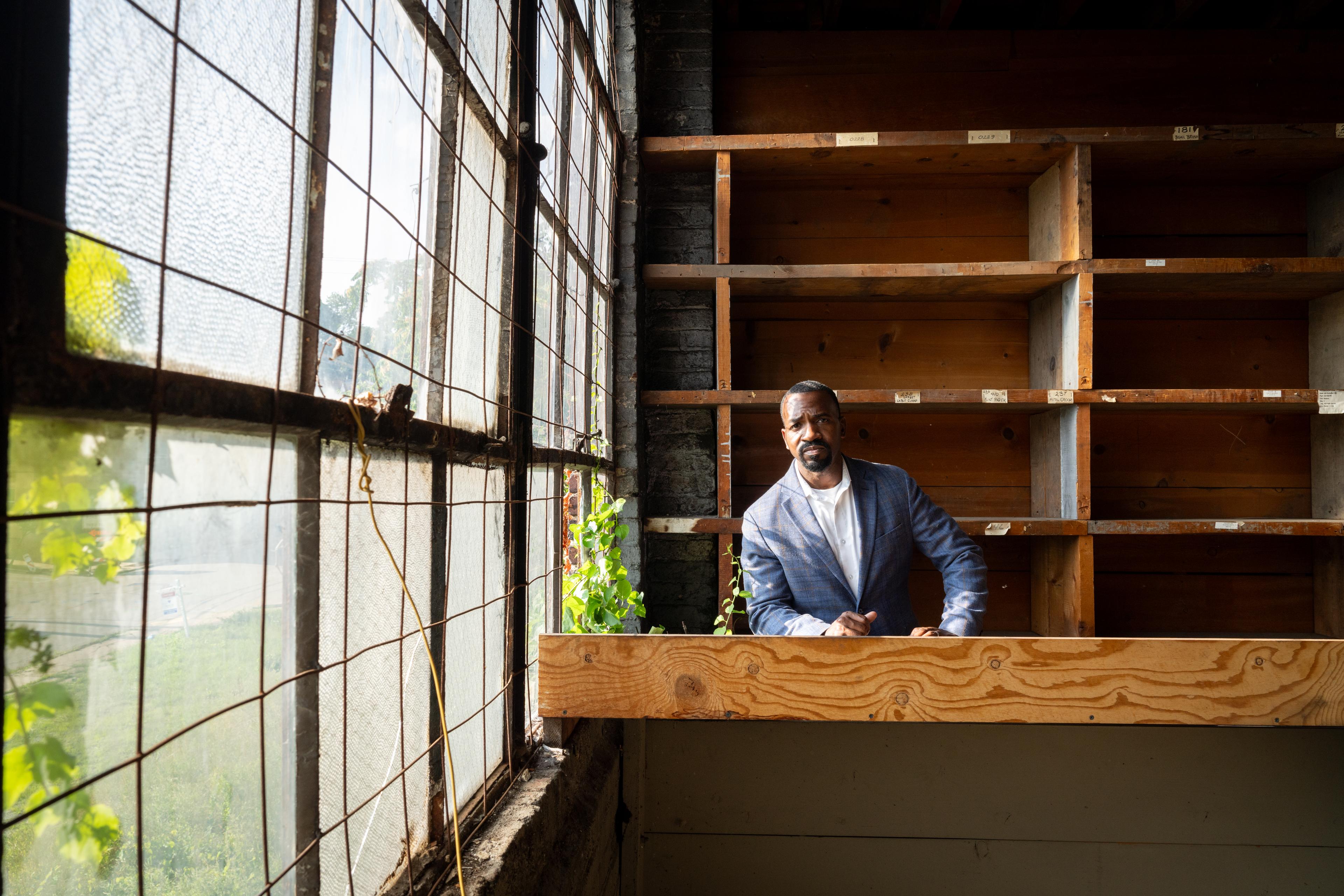
By Nancy Andrews for Commonplace
Who has inspired you over the course of your career?
I've definitely been inspired by my mentor; he wasn't a developer, but he was a wealthy, successful black man and he was really one of the earliest examples of that for me. He showed me what success looks like, not only in business, but also in marriage; I learned so much just by seeing the way he loved his wife and watching him move between different board meetings and professional spaces. He was truly an inspiration.
My mom was also an inspiration. Although she didn't have much economically, I think she instilled a drive and a fight in me that I saw her exhibit and exude every day; and she taught me about respect, integrity, hard work, and the value of education.
Along the way I've also been inspired by other developers. There’s a local developer, Irv Williams, who was the first Black developer to develop a commercial office building in the Hill District and early on he was definitely a source of inspiration for me. Besides him, the developers I see working on some of these huge projects today inspire me and also remind me of what I can accomplish with the proper resources.

By Nancy Andrews for Commonplace
What advice would you offer to emerging developers to help them launch or scale their businesses? And what is one thing you know now that you wish you knew when you first started in real estate?
I would say learn from someone that's doing what you want to do. Watch them, talk to them, glean wisdom from them. And if there's an opportunity, try to work for them or otherwise support them in their efforts. You'll learn so many things that are invaluable for your own business or your own career. Also, seek out opportunities to engage and understand their story. Your path may not be exactly the same, but hearing other stories will create new pathways of opportunity for you. And finally, I’d say try to master and understand the process; you don't have to be the implementer of every single facet or detail – you’ll have technical experts on your team – but make a real effort to understand every part of the process, especially the financial components of the project.
Something I wish I knew is how much intersectionality with politics there is in real estate development. Development is highly, highly political and I underestimated that at first. I started off kind of looking at it like it was real estate investing, just on a larger scale – and it is to some degree – but there's no politics when it comes to buying a house and flipping it, or buying it and being a landlord. But when it comes to development, there's politics on the community side and the elected officials’ side and I wish I understood more about that going into it.
What legacy do you hope to leave?
As I’ve mentioned, the legacy I’d like to leave for my family is one of generational wealth. But besides just leaving my children with money, I also want to instill in them the work ethic it took to build what I have today and to sustain it, as well as pass on the knowledge that I’ve been able to attain over the course of my career.
Apart from that, I also want to leave a legacy of inspiration. I’d like for my work to inspire my peers – not just Black and Brown peers, but everyone. And I hope that my work can serve as a model for current and future generations of developers to think about their work in a much more thoughtful, holistic way. Hopefully, that will lead to a greater appreciation for the way development impacts people’s everyday lives and how it can improve their communities from an economic, social, and environmental perspective.
And finally, I want kids, especially the ones who are growing up the way I did, to be able to look at my work and see something that gives them hope.

Derrick Tillman
Bridging the Gap
